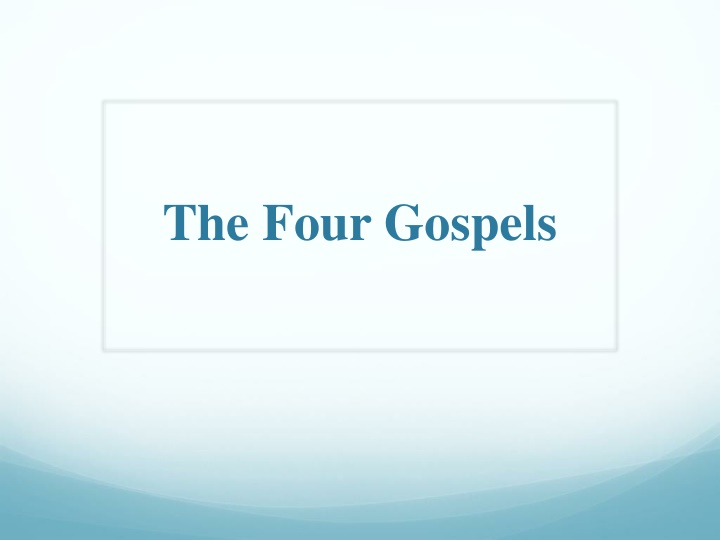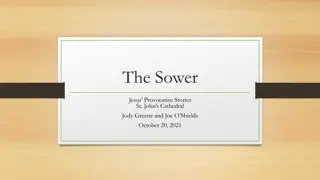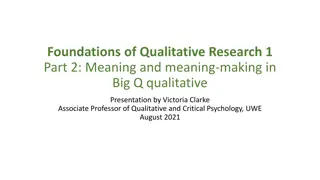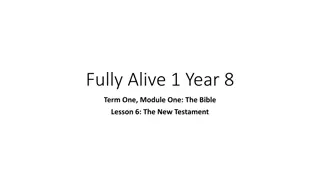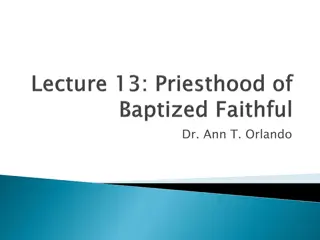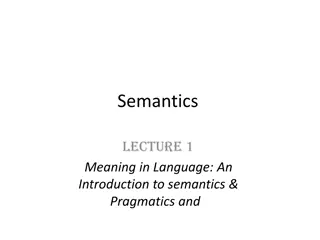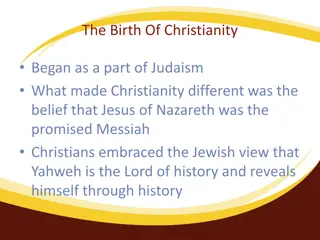The Four Gospels: Meaning and Significance
Delve into the evolution of the word "gospel" through history, from its origins in Old English and Greek to its profound significance in the New Testament era. Discover how the term transformed to encompass the life of Jesus Christ and the message of salvation, as portrayed in the four Holy Books. Uncover the rich symbolism and impact of the gospel in Christian teachings and scriptural references, highlighting its pivotal role in understanding the divine plan for humanity.
Download Presentation

Please find below an Image/Link to download the presentation.
The content on the website is provided AS IS for your information and personal use only. It may not be sold, licensed, or shared on other websites without obtaining consent from the author.If you encounter any issues during the download, it is possible that the publisher has removed the file from their server.
You are allowed to download the files provided on this website for personal or commercial use, subject to the condition that they are used lawfully. All files are the property of their respective owners.
The content on the website is provided AS IS for your information and personal use only. It may not be sold, licensed, or shared on other websites without obtaining consent from the author.
E N D
Presentation Transcript
Introduction to the Four Gospels
Introduction to the Four Gospels Meaning of the Word Gospel : I. The word gospel derives from the Old English g d-spell (rarely godspel), meaning good news or glad tidings. - It is a word-for-word translation of the Greek word euangelion (eu- good , -angelion message ). - The good tidings are that God sent His Only-Begotten Son into the world to save the believers. II. The word gospel was transformed in its meaning throughout history in three stages: 1. The first stage was in the writings of the ancient Greek composers. Gospel used to mean recompense for telling good news. It meant also
Introduction to the Four Gospels thanksgiving offering for hearing good news. 2. The second stage was in the writings of the later Greek composers. Gospel became to mean the good news themselves, as shown in the following from the Septuagint translation of the Old Testament: When someone told me, saying: Look, Saul is dead, thinking to have brought good news, I arrested him and had him executed in Ziklag the one who thought I would give him a reward for his news (2 Samuel 4:10) - The word gospel was used in the Book of Isaiah in the Septuagint translation to indicate the specific news of the sending of the Anointed One by God to save His people: O Zion, You who bring good tidings, Get up into the high mountain (Isaiah 40:9)
Introduction to the Four Gospels 3. The third stage was in the New Testament era, and this word was to refer to four Holy Books Gospels that contain the life of the Lord Jesus Christ. - In the New Testament, the word gospel took also a larger meaning encompassing the whole Christian message: Moreover, brethren, I declare to you the gospel which I preached to you, which also you received and in which you stand (1 Corinthians 15:1) - The Lord Christ declared the kingdom or the gospel of the kingdom and He Himself evangelized this gospel: Now after John was put in prison, Jesus came to Galilee, preaching the gospel of the kingdom of God, and saying: The time is fulfilled, and the
Introduction to the Four Gospels kingdom of God is at hand. Repent, and believe in the gospel (Mark 1:14-15) - The word gospel is repeated 100 times in the New Testament, to indicate the good news of salvation that God bestowed upon us by offering His Son Jesus Christ to lead us to the bosom of His Father through the Holy Spirit: For I am not ashamed of the gospel of Christ, for it is the power of God to salvation for everyone who believes, for the Jew first and also for the Greek (Romans 1:16) III. The word gospel is also related to some words and expressions, which reveal its role and significance in our life:
Introduction to the Four Gospels 1. The Gospel of God : Paul, a bondservant of Jesus Christ, called to be an apostle, separated to the gospel of God (Romans 1:1) - The gospel declares the nature of God as a lover of mankind, such joyful truth that is offered for our salvation. Some Gnostics portrayed God as an angry and severe punisher of man! The Evangelists, however, portrayed the loving Christ, thus the glad tidings from the Father declared in His Son. Christ accordingly, asserted that He came to fulfill the will of the Father. 2. The Gospel of Jesus Christ : The beginning of the gospel of Jesus Christ, the Son of God (Mark 1:1)
Introduction to the Four Gospels - While the Son came to declare to us the love of the Father, He Himself carries the same love. The gospel of the Father is the same as the gospel of the Son, and leads us to union with the Father through His Son. 3. My Gospel or Our Gospel : For our gospel did not come to you in word only, but also in power, and in the Holy Spirit and in much assurance, as you know what kind of men we were among you for your sake (1 Thessalonians 1:5) - Man is the object of the gospel, for God wants us to enjoy the gospel and live by it. The gospel is a divine grace bestowed upon man to accept it and believe in it, to serve it, and to defend it. We ought to defend the gospel with our private lives as well as with our words and behavior, and not become an obstacle to it.
Introduction to the Four Gospels - Thus the gospel does not only represent the love of God towards man, but mutual love between God and man. Man ought not to be negative or neutral toward the gospel, but continually acting positively in order to become the image if his Creator: Only let your conduct be worthy of the gospel of Christ (Philippians 1:27) 4. Preached to all the Nations : And the gospel must first be preached to all the nations (Mark 13:16) - It is not limited to Jews but includes all tongues, races, and nations. All get to know God, enjoy the union with Him, and be gratified in the eternal inheritance.
Introduction to the Four Gospels 5. The Gospel of Salvation : In Him you also trusted, after you heard the word of truth, the gospel of your salvation; in whom also, having believed, you were sealed with the Holy Spirit of promise (Ephesians 1:13) - In the gospel of salvation we receive the grace of forgiveness of our sins, and are freed from the bondage of sin to live with the spirit of victory. 6. The Gospel of Peace : And having shod your feet with the preparation of the gospel of peace (Ephesians 6:15) - The gospel leads us to the inner peace between the soul and the body
Introduction to the Four Gospels by reconciling us to God and to man. 7. Partakers of His Promise : That the Gentiles should be fellow heirs, of the same body, and partakers of His promise in Christ through the gospel (Ephesians 3:6) - The promises of God through His Son are fulfilled in the gospel. In the gospel we meet the Lord Christ s resurrection from the dead, and this gives us hope for eternity and our inheritance; we not only enjoy divine gifts, but God Himself. + Therefore, we understand that the Gospel is not just a book to be read, or a philosophy to be embraced, but it is a life of a powerful divine love offered by the Father through His Son Jesus Christ our Lord, that He
Introduction to the Four Gospels may carry the human soul to the bosom of the Father. There, the human soul enjoys the Father, declaring its love to Him and its faith in Him. Hence, it takes off to evangelize and witness to the Father in front of all without hindrance. + St. John Chrysostom comments on the interpretation of the word Gospel as good tidings saying: Yes, it is revoking the sentencing, forgiveness of sins, justification, sanctification, and salvation. It is adoption, inheritance of the kingdom of heaven, and a relation with the Son of God who came to deliver this message to all: to the enemies, to the lost, and to the sitting in darkness. Is there anything that equals this good news? God came on earth; man went to heaven, and all mixed together: angels mixed with multitudes of the earthly, and men accompanied angels and hosts of heavens.
Introduction to the Four Gospels IV. When was the word Gospel first used to mean written good news? - The word gospel was not intended at the beginning of Christianity to denote a written book. A clear evidence to such fact is the saying of the Lord to His Disciples after His Resurrection, when none of the Gospels have yet been written: Go into all the world and preach the gospel to every creature (Mark 16:15) - The use of the word Gospel to mean written good news came in the book Teachings of the Twelve Apostles. - The word Gospel was used in the middle of the 2ndcentury A.D. repeatedly and assertively to indicate the written story of the life of the Lord Christ.
Introduction to the Four Gospels - The plural word Gospels was used to indicate the four gospels and was used for the first time by Justin the Martyr in around A.D. 152, to refer to the Books that contain the Apostolic testimony to Jesus. The Need for a Written Gospel: If the Church survived for more than twenty years after the descending of the Holy Spirit on the Day of Pentecost without a written gospel, and lived the gospel and practiced its tenets in an abundant life in Jesus Christ, why then can t the Church through the ages live and practice the verbal gospel? Was it necessary to have a written Gospel? 1. Keeping the Tradition Intact: The verbal tradition had its important role in the Church, especially in the East. The written tradition was born not to replace the verbal one, but to
Introduction to the Four Gospels supplement it and to complete it. The Gospel keeps the tradition intact without deviation, and tradition lists the canonical Gospels, keeps them from deviating, and interprets its meanings. The Church recognizes only one Gospel, not two, whether given to it by verbal tradition or in writing, and lives it in its thoughts, worship, and behavior. Thus the Church adopted the Gospel in order to confirm that the life she lives is according to the principles delivered to her. [D. Guthrie] 2. Presenting the Lord Jesus Christ: The Gospels have their important rank among the Books of the Holy Bible because they inform us of the life of the Lord Christ on earth. Christ is the longing of the Gentiles, the Savior and Bridegroom of the Church, and the object of its joy day and night. It has to be noted that the Gospels are not just history book of the bibliography of Christ, however they are
Introduction to the Four Gospels deeper than that. They present the Lord Jesus Christ to us as the way of our salvation, so that we may abide in Him and live through Him, carrying the cross with Him to be glorified also with Him. 3. Evangelism: In their evangelism to the Jews and the Gentiles, the Evangelists depended generally on the verbal teachings. But when those being evangelized stated their interest in faith and started to inquire about the person of the Lord Christ, the Gospels, that are authentic apostolic documents, were to satisfy their inquiries. 4. The Liturgical Worship: The Gospels not only played the evangelizing and teaching roles, but had a major role in the worship life of the Church. When the Church met to
Introduction to the Four Gospels worship, they used portions of the Old Testament for readings and praising, especially the sections that prophesized of the Lord Christ. The believers, however, needed apostolic documents describing the bibliography of the Lord Christ, His teachings and miracles, His death and Resurrection and declaring the fulfillment of what was prophesized for in the Old Testament, to be a main part in their Christian worship. [D. Guthrie] Proper Title to the Gospel: + There are many titles given to the Gospels. The shortest title is According to Matthew. - Some manuscripts, however, bear the title The Gospel According to Matthew and some bear Gospel According to Matthew.
Introduction to the Four Gospels - These titles go back to an old age and seem to be given by the scribes, and were not from the origin. The Church accepted these titles since they refer to the author who wrote the Gospel. + The phrase According to Matthew has been misused in its meaning and its translation to other languages. It was wrongly and often translated to refer to the pronoun. For example, it reads: The Gospel of Matthew. This wrong translation leads to the impression that there is more than one Gospel, but in fact there is only one Gospel written by more than one person. + The proper translation to the title of the Gospel should be as follows: The Gospel written by St. Matthew, or The Gospel according to Matthew, or The Gospel by Matthew. - These proper translations lead to the following meanings:
Introduction to the Four Gospels 1. There is one Gospel or good news or good tidings, and more than one author wrote about it. 2. Many documented the events of the Gospel. 3. These translations clearly indicate the unity of the Gospel. Even though four Evangelists wrote it, each wrote a Book bearing his name; the Gospel is only one book with four faces. In other words, the Word of God was recorded in four texts, and the expression according to refers to the face or the form that its author gave it. Canonicity of the Four Gospels: + Canonical book means a book that is accepted and recognized by the Church as being inspired by the Holy Spirit, binding as a standard rule for the Christian style of life.
Introduction to the Four Gospels + The Church since the beginning of Christianity recognized that the canonic Gospels are only four which, along with the rest of the Books of the New Testament, compliment the Books of the Old Testament and have been considered inseparable of the Holy Scriptures. + To prove the canonicity of a book from the Bible we use two kinds of evidences: I. External Evidences: - Testimony of the Church tradition and of the Fathers of the Church: 1. The apostolic fathers of the Church (fathers who were disciples to the twelve Apostles): They referred only to verses from the four Gospels in their writings.
Introduction to the Four Gospels However, they did not refer to the author or verse of the Gospel. These referrals by the apostolic fathers are indirect evidence to the authenticity of the four Gospels and to their numbers. 2. The Syrian Translation known as Bishtio : It included only these four Gospels, and is dated to the middle of the 2nd century A.D. 3. Affidavit of Muratori : It was called Muratori after the Italian antiquity scientist, who issued it in A.D. 1740. He translated it from a manuscript that was kept in St. Ambrose Library in Milan. It was originally kept in the great Irish monastery of Bobbio. It is dated to A.D. 150-170, or to the middle of the 2ndcentury, which adds to its value.
Introduction to the Four Gospels This is an important affidavit asserting the canonry of the authoritative Scriptural Books and it lists the four Gospels. 4. Testimony of the scholar Tertullian (A.D. 160-220): In his book Against Marcion the Heretic that accepted only the Gospel according to Luke, Tertullian clearly indicated the existence of four, and only four, canonical Gospels. He fearlessly defended those four Gospels and their Apostle or Apostle closely related authors. II. Internal Evidences: - Evidences derived from the text itself: 1. Sources from which the four Evangelists obtained their material of the Gospels:
Introduction to the Four Gospels a) We must first stress that the holy Scriptures are all inspired by the Holy Spirit. The Holy Spirit worked through the Evangelists by directing, guiding, preventing them from making errors in writing, and showing them the facts that God wants to convey to man. All this was done without eliminating their personality in their writing. Each Evangelist kept his style that was influenced by his education and culture: Knowing this first, that no prophecy of Scripture is of any private interpretation, for prophecy never came by the will of man, but holy men of God spoke as they were moved by the Holy Spirit (2 Peter 1:20-21) All Scripture is given by inspiration of God, and is profitable for doctrine, for reproof, for correction, for instruction in righteousness, that the man
Introduction to the Four Gospels of God may be complete, thoroughly equipped for every good work (2 Timothy 3:16-17) But the Helper, the Holy Spirit, whom the Father will send in My name, He will teach you all things, and bring to your remembrance all things that I said to you (John 14:26) b) St. Matthew and St. John were two of the twelve Apostles of the Lord Christ. Therefore, they had first hand knowledge of the events they recorded. c) St. Mark, according to our Church s tradition, was one of the seventy Disciples. He was a relative of both Apostles Peter and Barnabas. He accompanied Paul and Peter in their evangelizing trips.
Introduction to the Four Gospels - St. Mark s house was the one chosen by Christ to celebrate the Passover in with His Apostles, institute the Sacrament of the Eucharist in it, and in it Christ washed the feet of His Disciples. In this house also was the Upper Room of Zion where the Holy Spirit descended on the Disciples, and is considered the first Church in the history of Christianity that was attended by Christ Himself and his Disciples. d) St. Luke asserts that he obtained his information from eye witnesses. He was thorough in his writing and never documented information before ascertaining its accuracy: Inasmuch as many have taken in hand to set in order a narrative of those things which have been fulfilled among us, just as those who from the beginning were eyewitnesses and ministers of the word delivered them to us, it seemed good to me also, having had perfect understanding of all things from the very first, to write to you an orderly account, most
Introduction to the Four Gospels excellent Theophilus, that you may know the certainty of those things in which you were instructed (Luke 1:1-4) - In addition, St. Luke was in Judea during the incarceration of the Apostle Paul in Caesarea of Palestine (A.D. 58-60). The Virgin Mary also was in Palestine during these days, and may be that St. Luke got in touch with her then and obtained many of the unique information that the Gospel which he wrote contains, such as the events of the birth of the Lord Christ recorded in its first 2 chapters. e) Accordingly, the Lady Virgin might have been a source of many of the facts contained in all the Gospels regarding the Annunciation, the Nativity, and the Visitation to Elizabeth. f) The Lord Christ Himself after His Resurrection remained among the
Introduction to the Four Gospels Disciples forty days and was explaining to them the secrets of the Kingdom of Heaven. The Lord Christ could have been also a source of information of many facts that the Disciples could not see on their own: To whom He also presented Himself alive after His suffering by many infallible proofs, being seen by them during forty days and speaking of the things pertaining to the kingdom of God (Acts 1:3) g) The fact that the Disciples doubted first before believing, such as St. Thomas who could not believe until he felt the wounds from the nails and spear. This indicates that the Disciples did not accept facts until they verified them. Even though we are used to blame St. Thomas of doubting, his doubting became a reason for obtaining stronger evidence of the Resurrection of the Lord Christ from the dead.
Introduction to the Four Gospels - Also, right after the Resurrection, when the Marys went back to inform the rest, the Disciples did not believe off-hand until they saw for themselves the empty tomb! These events and many others testify that the Disciples did not believe the facts until they verified their truthfulness. 2. If we assume that the Disciples tried to deceive us by fabricating many stories, and attributed many miracles that did not occur to the Lord Christ, the following evidence will refute this theory: a) The four Evangelists were writing from different places at different times. How would they then tell the same stories in order to deceive people? b) The Evangelists mentioned names of personalities and towns. History confirms such personalities and the events that they are related to.
Introduction to the Four Gospels c) When the Gospels were written and published, many of the personalities mentioned in them were still alive. That is, the Gospels presented living facts that could not be denied or used for deceiving. d) If the Evangelists were imposters and intended a kind of deceit, they would not have presented Christ as a weak Man that gets crucified, dies, and get buried! Christ was ridiculed a lot in His ministry, and was born in a poor manger intended for animals! He did not have a place to lean His head upon! e) The Gospels present to the common reader simple facts. They tell the stories without illustrations, or eloquence of text, or exclamation, or notation and commentary. f) They honestly and plainly record the weakness of the Disciples and their fall, including the Evangelists themselves, recording their own
Introduction to the Four Gospels shameful behavior. They described Peter s denials, the escape of the Disciples, and Judas Iscariot s betrayal to the Lord Christ. They recorded the admonishing of the Lord Christ to them and the lack of their understanding, their need to faith and their hopelessness after crucifixion. The Gospels did not hide, alter or justify any and did not exaggerate any event. In addition, they indicated their modest professions before being called to the Discipleship, such as fishermen and tax collector. - If these events were not true, it would not suit them to fabricate such stories! g) The writers did not care for their own reputation, and refrained from mentioning their names. Their only mission was to tell the story of the Lord Jesus that by itself carries an undisputable weigh, joy, and awe to the heart of all who read it, who love the truth.
Introduction to the Four Gospels + Heretics throughout history have tried to slip into the Scriptures fake books and gave them a gospel title in order to deceive and mislead the believers and reap material and prestigious gains. - Examples of such fake gospels are the gospel of James, the gospel of the Hebrews, the gospel of the Egyptians, the gospel of Peter, the gospel of Thomas and the gospel of Barnabas, which appeared in the middles ages. - The early Church never adopted these false books, but to the contrary, it exposed them, and only canonized the four Gospels that we are now using. Relevance of the Existence of Four Gospels: 1. From the very beginning the Church recognizes four Gospels only as
Introduction to the Four Gospels canonical books that constitute a major part of the New Testament and relates these four Gospels to four main covenants between God and man throughout the history of mankind: a) God s covenant with Noah, with the rainbow as its sign. b) His covenant with Abraham, with circumcision as its sign. c) The Law of Moses, with the blood of animals as its sign. d) The New Testament, with the precious blood of our Lord Jesus as its sign. 2. As the river that went out of Eden and parted in four, the same may be said of the Gospel of the Lord Christ, it is one Gospel in four glad tidings: Now a river went out of Eden to water the garden, and from there it
Introduction to the Four Gospels parted and became four riverheads (Genesis 2:10) 3. The Church relates the four Gospels to the four incorporeal living creatures: a) In Ezekiel s revelation: Also from within it came the likeness of four living creatures. And this was their appearance: they had the likeness of a man. Each one had four faces, and each one had four wings As for the likeness of their faces, each had the face of a man; each of the four had the face of a lion on the right side, each of the four had the face of an ox on the left side, and each of the four had the face of an eagle (Ezekiel 1:5- 6,10)
Introduction to the Four Gospels b) In the Revelation to St. John the Divine: And in the midst of the throne, and around the throne, were four living creatures full of eyes in front and in back. The first living creature was like a lion, the second living creature like a calf, the third living creature had a face like a man, and the fourth living creature was like a flying eagle (Revelation 4:6-7) c) The Church depicted from the opening of each Gospel its reason for selecting the appropriate symbol for it: i. The first living creature that is like a lion symbolizes the Gospel according to St. Mark: - In the opening, we read:
Introduction to the Four Gospels The voice of one crying in the wilderness (Mark 1:3) - It refers to Christ, the Lion of the tribe of Judah, to His effective ministry, and to His kingly might and authority: Behold, the Lion of the tribe of Judah, the Root of David, has prevailed to open the scroll and to loose its seven seals (Revelation 5:5) - It might also refer to the lion that St. Mark was able to tame in the name of the Lord. ii. The second living creature that is like a calf or an ox symbolizes the Gospel according to St. Luke:
Introduction to the Four Gospels - St. Luke opens the Gospel according to him with references to priesthood and sacrifices, where this Gospel introduces to us the priesthood and sacrificial ministry of Christ, as well as Christ, the servant of mankind. - The ox is both a domestic and sacrificial animal; he is a symbol of Christ s sacrifice that reconciles us to the Father. - More than any other evangelist, St. Luke conveys to us the image of the redeemer Christ, who came to save sinners. He was both the sacrificial Lamb and the offering Priest who offer the sacrifice. iii. The third living creature that has a face like a man symbolizes the Gospel according to St. Matthew: - This Gospel s opening lists the genealogy of the Lord Christ, and talks
Introduction to the Four Gospels about the Son of Man who is a descendent of the Prophet David: The book of the genealogy of Jesus Christ, the Son of David, the Son of Abraham (Matthew 1:1) iv. The fourth living creature that is like a flying eagle symbolizes the Gospel according to St. John: - St. John in the opening of the Gospel takes us in a flight up high to the extreme heights of divinity: In the beginning was the Word, and the Word was with God, and the Word was God (John 1:1)
Introduction to the Four Gospels - He talks about the elation and depth of the divinity of the Lord Christ, for the eagle cuts through the atmospheric layers and hides behind the clouds. - The fourth living creature also symbolizes the gift of the Holy Spirit that spread its wings around the Church. d) St. Ambrose, Bishop of Milan, in the opening of his book Study of the Gospel according to Luke' writes: Our Lord Jesus Christ is portrayed in the four Gospels by symbols of the four incorporeal living creatures. He is the Man, He is the Lion, He is the Ox, and He is the Eagle He is Man, for He is born of Mary. He is Lion, for He is mighty. He is Ox, for He is the sacrificial Lamb. And He is Eagle, for He is the resurrection.
Introduction to the Four Gospels e) Testimony of St. Irenaeus, a disciple of St. Polycarp, who in turn was a disciple of St. John the Beloved: - In his book Against Heresies, St. Irenaeus wrote a whole chapter titled: Evidence to the existence of no more or less than four Gospels. - He looked at the four Gospels as a unity and called them the Gospel with the four faces. - He ties the number four to the cherub with the four faces, to the four spirits of the universe, and to the four faces of the earth. - He said: The number of Gospels could not be more or less than what we have; for there are four corners to the world we live in, four main winds, and Christianity was spread in the whole world. Since the Gospel is the pillar and ground of the church, and the spirit of life, it was befitting...
Introduction to the Four Gospels that the Church should have four pillars in order that it enjoys incorruption from all sides, and that it refreshes all humanity. From this fact, the Word who sits on the cherubim, the Pantocrator, when He revealed Himself to man, He presented us with a Gospel in four forms, tied together by one Spirit. The Prophet David in this regard says: You who dwell between the cherubim, shine forth! (Psalm 80:1) And the cherub has four faces representing the economy of salvation exerted in the Son of God. Scripture says the following regarding the four living creatures: The first was like a lion, and is an indication of Christ s effective work, His magic, and His kingly authority. The second was like an ox, and is an indication of Christ s sacrificial and priestly role. The third had a face like a man, and is an indication of Christ s incarnation. The...
Introduction to the Four Gospels fourth was like a flying eagle, and is an indication of the gift of the Holy Spirit that hovers with His two wings over the Church. The four Gospels with Christ at their center are in agreement with the above analogies : And I looked, and behold, in the midst of the throne and of the four living creatures, and in the midst of the elders, stood a Lamb as though it had been slain (Revelation 5:6) Wisdom Behind the Existence of Four Gospels: 1. Divine inspiration offered us one Gospel, that is, the Gospel of our Lord Jesus Christ through four Evangelists: Matthew, Mark, Luke, and John. These evangelists reveal four sides of one Gospel; each one is portrayed
Introduction to the Four Gospels from a different angle. It is like the one pearl that each author describes from his point of view. 2. The Gospels, especially the first three, show similarity in content, order and statement, in terms of their content of the life, ministry, and sayings of the Lord Christ and are thus called Synoptic Gospels, nevertheless in their essence each offer a face of the life and saving work of the Lord. 3. The Gospel according to St. John appears to have a unique way, as it was written towards the end of the 1stcentury, when the other Gospels have already been known and circulated. St. John wrote mainly to attest to the divinity of Christ and His holy incarnation, to counteract the heresies that emerged at that time. He wrote to detail some events and to record others that were not mentioned by the other Evangelists, which refute those heresies.
Introduction to the Four Gospels 4. While the four Gospels have much material in common, and each Gospel affirms what the others are saying, yet they differ from each other so that they are complementing each other. 5. The Gospel of Christ according to Matthew, or Mark, or Luke, or John is none but a foursome true picture of the person of Christ and His ministry. 6. While a statue is better than a picture, for it can be viewed from all angles, the same is for the foursome picture of Christ, witnessed by four Evangelists, that enables the viewer to enjoy its beauty from various points of view. The viewer always gains new knowledge. Thus the Gospels express four angles or faces or pictures of one Gospel or good news. 7. The person of the Lord Christ is like a vast ocean, and the four Gospels are likened to floodlights shining over this unique Person.
Introduction to the Four Gospels 8. Each of the four Evangelists intended to portray a particular view and show a side of the Lord Christ and His ministry as it affected him, and to serve the purpose that he wrote for and whom he addressed the Gospel to. The end product of the four Gospels is a complete picture of the Lord Christ and His ministry that sticks in our mind. 9. Thus each Gospel was written for a certain purpose and for a particular group of people, in order for every person to understand that Christ came for him and to redeem him. The Spirit of God moved the Evangelists and they wrote about the need of all men, without prior agreement or conspiracy on what they should write. This explains some of the apparent discrepancies among the four Gospels. 10. Discrepancies may be explained by having an Evangelist document what the other Evangelist had left, and each one of them was documenting the events mostly suiting the purpose of why he was writing.
Introduction to the Four Gospels This proves the truthfulness of their witnessing and demonstrates to all of us that the Evangelists were independent and never consulted one another. 11. Also some discrepancies could simply be due to different Evangelists recording similar events; that is different incidents having the same nature or category, which have occurred independently. 12. The church fathers cared and talked about the unity of the Evangelists in their description of the events, explaining what might seem to some as controversies: - St. Augustine wrote a book in the 4thcentury about the harmony among the Evangelists, titled De Consensu Evangelistarum. - The scholar Origen in the 2ndcentury A.D. wrote about the agreement
Introduction to the Four Gospels among the four Evangelists and the harmony between their Gospels and the rest of the New Testament Books, even though each Book discusses the facts from a different point of view than the other Books. Origen compares the Holy Book to a harp with many different cords that deliver a beautiful and harmonious melody. Origen says: As every cord of a harp gives a particular sound that appears different from other cord s sound, and the unmusical man that does not fathom the music harmony might think that the cords are not balanced, for they give different sounds, so are those who are not used to hearing and recognizing the harmony of God (His words) in the Holy Books. He might think old does not agree with the new, or the Prophets with the Law, or the Gospels with each other and with the rest of the Disciples. However, the connoisseur of the music of God is like a wise man in
Introduction to the Four Gospels words and in deeds, and is considered another David. By the skill of his interpretation he may bring the melody of the music of God. At the proper time, he may hit the cord of the Law, at another time the cord of the Gospels that is in harmony with the first cord, then the cord of the Prophets. When wisdom dictates, he may hit the apostolic cords such as the Gospels that are in harmony with the prophetic cords. Therefore, the Holy Book is a tool of God, one, complete, and harmonious. It gives through the distinctive sounds, the sound of the only salvation to those willing to learn. This harp resists and eliminates the work of all evil spirits, as it happened with David the musician, when he used it to quiet the evil spirit that used to torture Saul : And so it was, whenever the spirit from God was upon Saul, that David would take a harp and play it with his hand. Then Saul would become refreshed and well, and the distressing spirit would depart from him (1 Samuel 16:23)
Introduction to the Four Gospels 13. Regardless of the purpose of each Evangelist in writing, it is clear that the Holy Spirit inspired the Gospels. They altogether include enough biography and teachings of our Savior to lead His Church in faith and ministering throughout all generations. The Four Gospels are Not Mere Historic Books: 1. The four Evangelists in reality are not historians sketching the bibliography of the Lord Christ according to the scientific definition of history. 2. They are, however, truthful witnesses declaring the good news that affects our lives, making known the light of the resurrected Christ and the bestowing of the Spirit of God upon us. 3. The historic bibliography from this point of view is ministering to our
Introduction to the Four Gospels spiritual life and to our union with the Savior who is resurrected from the dead. 4. The four Gospels are not just historic Books meant to record all that is related to the life and teachings of the Lord Christ. They are not complete record of the bibliography of the Lord Christ on earth. Many facts known to the Disciples are not recorded in their writings: And truly Jesus did many other signs in the presence of His disciples, which are not written in this book; but these are written that you may believe that Jesus is the Christ, the Son of God, and that believing you may have life in His name (John 20:30-31) And there are also many other things that Jesus did, which if they were written one by one, I suppose that even the world itself could not
Introduction to the Four Gospels contain the books that would be written. Amen (John 21:25) 5. As evidence to this fact, let us ask the following questions: a) What did the four Gospels tell us of the first thirty years of the life of the Lord Christ, except those relatively short segments about the birth of Jesus and His visit to Jerusalem with His parents at the age of twelve? b) What did the four Gospels contain of the teachings of the Lord Christ after His resurrection during the forty days till His holy Ascension? c) Why did not the four Gospels keep the chronological sequence of the events surrounding the Lord Christ? The only exceptions are the events of the nativity and the events of the passion of Christ during the Holy Week.
